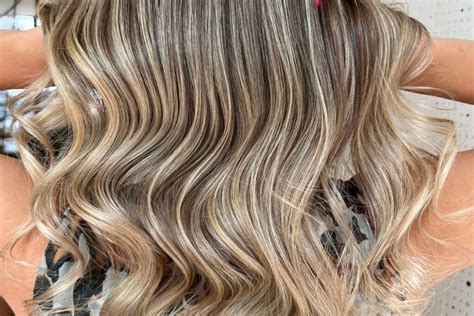Introduction
Balayage, a French technique meaning “to sweep” or “to paint,” is a popular hair coloring method that creates natural-looking highlights. Unlike traditional foiling, which involves wrapping hair in foil, balayage is painted on freehand, resulting in a more gradual and blended look.

But when it comes to balayage, the question of whether to go for a partial or a full highlight arises. Each option offers distinct benefits and drawbacks, depending on your hair texture, goals, and maintenance preferences.
Understanding Partial Balayage
What is it?
Partial balayage involves highlighting only certain sections of your hair, typically framing the face or creating lighter strands on the top layers. It’s an ideal choice if you want to add subtle dimension and brightness to your hair without making a drastic change.
Benefits:
- Low-maintenance: Partial balayage grows out gracefully and can last up to 6 months without major touch-ups.
- Customizable: You can choose the level of lightness and the placement of the highlights to suit your preferences.
- Healthy for hair: Partial balayage minimizes damage since only a portion of your hair is colored.
Understanding Full Balayage
What is it?
Full balayage involves highlighting the entirety of your hair, creating a more dramatic and noticeable effect. It’s suitable for those who want a complete transformation or a significant change in hair color.
Benefits:
- Bold and transformative: Full balayage creates a striking and dimensional look that can completely alter your appearance.
- Long-lasting: Full balayage can last up to 6 months or more with proper maintenance.
- Versatile: You can experiment with different colors and techniques to achieve a personalized and unique style.
Which Technique Is Right for You?
The choice between partial and full balayage depends on several factors:
Hair Texture:
- Thin hair: Partial balayage is recommended to avoid overwhelming the hair.
- Thick hair: Either technique can be suitable, but full balayage may require more color and multiple sessions to achieve desired results.
Hair Goals:
- Subtle change: Partial balayage provides a natural and gradual enhancement.
- Dramatic change: Full balayage offers a more transformative and impactful look.
Maintenance Preferences:
- Low-maintenance: Partial balayage requires fewer touch-ups and less frequent salon visits.
- High-maintenance: Full balayage requires regular touch-ups every 6-8 weeks to maintain its vibrancy and prevent root growth from becoming noticeable.
Table 1: Comparing Partial and Full Balayage
| Feature | Partial Balayage | Full Balayage |
|---|---|---|
| Level of coverage | Certain sections | Entire hair |
| Maintenance | Low | Moderate to high |
| Cost | Lower | Higher |
| Time required | 2-4 hours | 3-6 hours or more |
| Suitability | Subtle enhancement | Dramatic change |
Table 2: Choosing the Best Balayage Technique for Your Hair Texture
| Hair Texture | Partial Balayage | Full Balayage |
|---|---|---|
| Thin hair | Recommended | Optional |
| Medium hair | Optional | Recommended |
| Thick hair | Optional (may require multiple sessions) | Recommended |
Table 3: Maintenance Tips for Partial and Full Balayage
| Technique | Maintenance |
|---|---|
| Partial Balayage | Touch-ups as needed (every 6-12 months) |
| Full Balayage | Regular touch-ups every 6-8 weeks |
| Both | Use color-protecting shampoo and conditioner |
| Both | Avoid excessive heat styling |
| Both | Get regular trims to remove split ends |
Table 4: Cost Comparison of Partial and Full Balayage
| Hair Length | Partial Balayage | Full Balayage |
|---|---|---|
| Short hair | $100-$250 | $150-$300 |
| Medium hair | $150-$350 | $200-$400 |
| Long hair | $200-$450 | $250-$500 |
Strategies for Effective Balayage
- Consult a professional: Seek advice from an experienced hair stylist who can assess your hair condition, goals, and recommend the best balayage technique for you.
- Choose the right color: Consider your skin tone, eye color, and personal style when selecting the highlight color.
- Protect your hair: Use products that are formulated for color-treated hair to maintain the vibrancy and health of your locks.
- Be patient: Balayage can be a time-consuming process, especially for full highlights. Avoid rushing the appointment or expecting instant results.
Step-by-Step Approach to Balayage
For Partial Balayage:
- Section hair and apply color to the desired areas, typically around the face and towards the mid-lengths.
- Use a brush or comb to gently blend the color into the hair.
- Process and rinse according to the color manufacturer’s instructions.
For Full Balayage:
- Section hair into small sections.
- Apply color to the entire length of each section, from root to tip.
- Use a brush or comb to distribute the color evenly.
- Process and rinse according to the color manufacturer’s instructions.
Conclusion
Whether you opt for partial or full balayage, this versatile hair coloring technique can transform your look and boost your confidence. By understanding the differences between the two techniques and consulting with a professional, you can find the perfect balayage solution for your individual needs.
